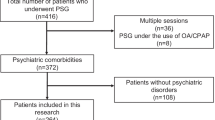Abstract
Study Objectives: To assess the incidence of polysomnographically defined obstructive sleep apnea (OSA) in pediatric psychiatric clinic patients reporting daytime sleepiness on questionnaire, and to identify diagnostic correlates for OSA in this grouping. Design: Prospective and observational. Setting: Outpatient pediatric psychiatry clinic, outpatient sleep medicine clinic, AASM-accredited hospital-based sleep laboratory. Subjects: Children aged 3 to 16 years, reporting daytime sleepiness on questionnaire (N= 74); exclusions: adenotonsillectomy and trisomy 21. Interventions: Parents and children completed a questionnaire designed and validated for identifying pediatric patients with OSA at the pediatric psychiatry clinic. Patients with at least one positive response as to daytime sleepiness (N= 74) were referred for a history and physical by a board-certified sleep medicine physician before in-hospital polysomnography utilizing a routine apnea montage with parent or legal guardian sleeping in room. Results: Mean apnea-hypopnea index (AHI) for this pediatric psychiatry clinic grouping was 5.5. Of these patients, 39.2% had an AHI > 5.0. Mean AHI for patients with attention deficit/hyperactivity disorder (AD/HD) was 7.1; without AD/HD it was 4.5 (p< 0.05). Mean AHI for patients with tonsillar hypertrophy was 6.5 compared with 4.4 for those without tonsillar hypertrophy (p< 0.05). Conclusion: In a clinical grouping of pediatric psychiatry patients reporting daytime sleepiness by questionnaire, polysomnographically defined OSA is common. Both AD/HD as diagnosed using DSM-IV criteria and tonsillar hypertrophy based on clinical exam by a sleep medicine physician are diagnostic correlates for polysomnographically defined OSA in this pediatric psychiatry clinic grouping of patients.
Similar content being viewed by others
References
Ali NJ, Pitson DJ, Stradling JR. Snoring, sleep disturbance, and behavior in 4–5 year olds. Arch Dis Child 1993;68:360–366
Brouilette R, Hanson D, David R et al. A diagnostic approach to suspected obstructive sleep apnea in children. J Pediatr 1984;105:10–14
Gislason T, Benediktsdottir B. Snoring, apneic episodes, and nocturnal hypoxemia among children 6 months to 6 years old. An epidemiological study of lower limit of prevalence. Chest 1995;107:963–966
Schechter MS. Section on Pediatric Pulmonology, Subcommittee on Obstructive Sleep Apnea Syndrome. Technical report: diagnosis and management of childhood obstructive sleep apnea syndrome Pediatrics 2002;109:e69(1–14)
Greene MG, Carroll JL. Consequences of sleep-disordered breathing in childhood. Curr Opin Pulm Med 1997;3:456–463
Chervin RD, Archibold KH, Dillon JE et al. Inattention, hyperactivity, and symptoms of sleep disordered breathing. Pediatrics 2002;109:449–456
Carroll JL, McColley SA, Marcus CL, Curtis S, Loughlin GM. Inability of clinical history to distinguish primary snoring from obstructive sleep apnea in children. Chest 1995;108:610–618
Chervin RD, Hedger K, Dillon JE, Pituch KJ. Pediatric sleep questionnaire (PSQ): validity and reliability of scales for sleep-disordered breathing, snoring, sleepiness, and behavioral problems. Sleep Med 2000;1:21–32
Goodwin JL, Enright PL, Kaemingk KL et al. Feasibility of using unattended polysomnography in children for research—report of the Tucson Children’s Assessment of Sleep Apnea study (TuCASA). Sleep 2001;24:937–944
Szatmari P. The epidemiology of attention-deficit hyperactivity disorder. Child Adolesc Psychiatr Clin N Am 1992;1:361–371
Simonds JF, Parraga H. Sleep behaviors and disorders in children and adolescents evaluated at psychiatric clinics. J Dev Behav Pediatr 1984;5:6–10
Weissbluth M, Davis AT, Poncher J, Reiff J. Signs of airway obstruction during sleep and behavioral, developmental, and academic problems J Dev Behav Pediatr 1983;119–121
Marcotte AC, Thacher PV, Butters M, Bortz J, Acebo C, Carskadon MA. Parental report of sleep problems in children with attentional and learning disorders. J Dev Behav Peds 1998;19:178–186
Chervin RD, Dillon JE, Bassetti C, Ganoczy DA, Pituch KJ. Symptoms of sleep disorders, inattention, and hyperactivity in children. Sleep 1997;20:1185–1192
Suen SS, Arnold JE, Brooks LJ. Adenotonsillectomy for treatment of obstructive sleep apnea in children. Arch Otolaryngol Head Neck Surg 1995;121:525–530
Shintani T, Asakura K, Kataura A. The effect of adenotonsillectomy in children with OSA. Int J Pediatr Otorhinolaryngol 1998;44:51–58
Ali NJ, Pitson D, Stradling JR. Sleep disordered breathing: effects of adenotonsillectomy on behavior and psychological functioning. Eur J Pediatr 1996;155:56–62
Francis A Chair, Task Force on DSM-IV DSM-IV—Diagnostic and Statistical Manual of Mental Disorders. 4th ed Washington, DC American Psychiatric Association 1994
Nieminen P, Tolonen U, Lopponen H. Snoring and obstructive sleep apnea in children—a 6-month follow-up study. Arch Otolaryngol Head Neck Surg 2000;126:481–487
Lipton AJ, Gozal D. Obstructive sleep apnea syndrome from pediatrics/pulmonology. Pediatrics E Med J 2002;3:1–20
Guilleminault C, Korobkin R, Winkle R. A review of 50 children with obstructive sleep apnea syndrome. Lung 1981;159:275–287
Rosen CL, D’Andrea L, Haddad GG. Adult criteria for obstructive sleep apnea do not identify children with serious obstruction. Am Rev Respir Dis 1992;146:1231–1234
Redline S, Tishler PV, Schluchter M, Aylor J, Clark K, Graham G. Risk factors for sleep-disordered breathing in children: associations with obesity, race, and respiratory problems. Am J Respir Crit Care Med 1999;159:1527–1532
Rechtschaffen A, Kales A. A Manual of Standardized Terminology: Techniques and Scoring Systems for Sleep Stages of Human Subjects Los Angeles, CA UCLA Brain Information Service/Brain Research Institute 1968
Author information
Authors and Affiliations
Corresponding author
Rights and permissions
About this article
Cite this article
Pagel, J.F., Snyder, S. & Dawson, D. Obstructive Sleep Apnea in Sleepy Pediatric Psychiatry Clinic Patients: Polysomnographic and Clinical Correlates. Sleep Breath 8, 125–131 (2004). https://doi.org/10.1007/s11325-004-0125-0
Issue Date:
DOI: https://doi.org/10.1007/s11325-004-0125-0



